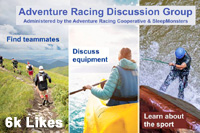The Abu Dhabi Adventure Challenge
The Desert Islands
Rob Howard / 14.12.2008


The first part of the route crosses more open sea, while the later part of the day stays close to the inshore islands and may be more sheltered. However, until the teams land at Mirfa I won’t have much more information to give you as the teams are inaccessible at present, and the race staff and press have a ferry crossing and a long journey round to Mirfa to meet up with them.
If you’ve read the earlier reports you’ll know the race leaders are called ‘Desert Islands’. They are sponsored by the government agency who are starting the development of the islands into a major adventure tourist destination, and this was, in part, why the course takes the route it does and visited Sir Bani Yas, which is the principal attraction and first island to be developed.
It’s a truly remarkable place. The island was previously owned by the Sheikh Zayed, the former president of Abu Dhabi and founder of the UAE federation and his palace is still maintained on the island. (It is used the late Sheikh’s family only very occasionally but has a permanent staff of 120!) Over the course of 25 years Sheikh Zayed stocked the island with thousands of animal species, including rare Arabian species now extinct in the wild), and began a process to ‘green’ the island, planting trees, and irrigating the land. There are now nearly 3 million trees watered by 21,000 km of irrigation piping with the water coming from desalination plants on the mainland in two pipelines.
Now the island is the centrepiece for the Desert Islands development and a unique eco-reserve. The island is currently being fenced to separate the African and Arabian species in wildlife parks and some of the animals are being shipped off and integrated in programmes to repopulate endangered speices. (And in the case of the Sand Gazelles because there are far too many on the island!)







 SleepMonsters
SleepMonsters



